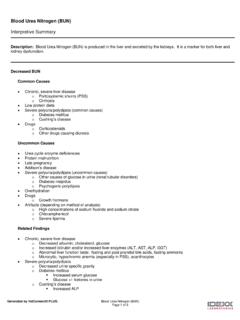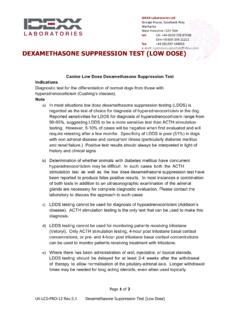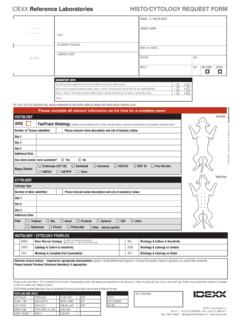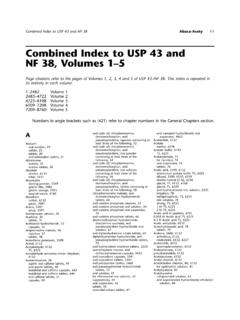Transcription of Canine ACTH Stimulation Testing Protocol Indications
1 Page 1 of 2 Document number: UK-LCS-PRO-11 Revision no: Title: Canine ACTH Protocol IDEXX Laboratories Ltd Grange House, Sandbeck Way Wetherby West Yorkshire LS22 7DN tel: UK: +44 (0) 20 378 87508 Eire: +353 (0) 156 21211 fax: +44 (0) 1937 544001 e-mail: Canine ACTH Stimulation Testing Protocol Indications ACTH Stimulation Testing is used as a diagnostic test for hypoadrenocorticism (Addison s disease) and hyperadrenocorticism (Cushing s disease) a) It is the only test available for diagnosis of hypoadrenocorticism (Addison s disease) in dogs. b) It is commonly used as a screening test for diagnosis of hyperadrenocorticism (Cushing s disease) c) It is used to monitor adrenal reserve in dogs receiving treatment for hyperadrenocorticism with trilostane (Vetoryl) and occasionally mitotane (Lysodren). Note a) ACTH is not licensed for use in the dog. b) The ACTH Stimulation test has lower sensitivity but higher specificity than the LDDS for the diagnosis of Canine hyperadrenocorticism.
2 C) Results of ACTH Stimulation can be affected by prior glucocorticoid administration (including topical medications), stress, and chronic disease. Final interpretation of the results must be made in the context of the history and clinical findings. ACTH Stimulation tests can be associated with occasional false positive and negative results and results cannot be interpreted in isolation. d) If exogenous glucocorticoids have been administered, ACTH Testing should be delayed for at least 2-4 weeks after the complete withdrawal of therapy to allow normalization of the pituitary-adrenal axis (longer for long acting glucocorticoid preparations). e) Other drugs including delmadinone (Tardak) and progestagens such as proligestone (Delvosteron) may affect ACTH test results for variable periods of time. Please contact the laboratory for further advice on Testing these cases. Protocol 1) Collect 1-2 mL blood in plain/gel tube. Serum should be spun and separated and labelled with the name of the patient and the time of the sample.
3 For patients receiving trilostane (Vetoryl) to control hyperadrenocorticism the pre-ACTH sample should be drawn 2-6 hours post administration of trilostane to allow adequate assessment of control. For all other situations time of day does not impact the test. 2) Administer ACTH (either as compounded tetracosactide, Synacthen aqueous, or Synacthen depot according to the appropriate Protocol . 3) Collect 1-2 mL blood in plain/gel tube 60 minutes post ACTH injection. Serum should be spun and separated and labelled with the name of the patient and the time of the sample. 4) Submit separated serum samples and request form to the laboratory. Please include patient history, including drug history, and select the appropriate test code (ACTH for ACTH Stimulation Testing for diagnosis vs ACTV for ACTH Stimulation Testing for monitoring) to allow interpretation of the result. Page 2 of 2 Document number: UK-LCS-PRO-11 Revision no: Title: Canine ACTH Protocol IDEXX Laboratories Ltd Grange House, Sandbeck Way Wetherby West Yorkshire LS22 7DN tel: UK: +44 (0) 20 378 87508 Eire: +353 (0) 156 21211 fax: +44 (0) 1937 544001 e-mail: Available forms of ACTH for Stimulation Testing ACTH form Concentration Dose Route of administration Notes Tetracosactide (veterinary special) mg/mL in 2 ml vials a) 5 micrograms/kg or b) vial for patients < 5 kg; 1 vial for patients > 5kg.
4 Dogs > 40 kg should have dose calculated because they may need more than 1 vial IV compounded based on individual prescriptions (contact Dechra) Any remaining product in the vial should be discarded as there is no in-use stability data for this product because it is a special. Also there is no information on whether the product can be frozen or thawed Synacthen aqueous (tetracosactide) mg/mL in 1 mL ampoule a) 5 micrograms/kg IV or b) vial for patients < 5 kg; 1 vial for patients > 5kg. Can be IV or IM IM or IV Limited availability in the UK since 2014 Synacthen depot (tetracosactide adsorbed to zinc phosphate) 1 mg/mL vial for patients < 15 kg; 1 vial for patients >15 kg MUST go IM Less consistent results for ACTH Stimulation Testing than other forms of tetracosactide







